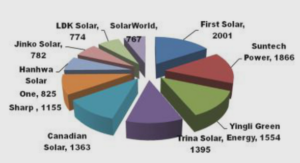Télécharger mémoire online préparation and characterization of transition métal silicides (-FeSi II), tutoriel & rapport PDF.
Introduction
Iron ion implantation into silicon is a suitable way for the formation of buried semiconductingiron disilicide ( ) layers which have interesting and promising properties and oer various applications. The 2 phase is orthorhombic with lattice constants =09865, =07791, and =07833 at room temperature [1].
The is a novel direct band gap semiconductors with =085 087 ,
which matches the wavelength of 15 of silica optical fibers [2, 3, 4,5]. Thus, making it suitable for optoelectronic communications. Therefore, phase is potentially of interest for use in future solar cells, infrared detectors and light emitters as well as thermoelectronics devices [6]. The is also known to be a Kankyo semiconductor (ecological friendly semiconductor)[7].
Several techniques have been used for the preparation of reactive deposition epitaxy [8], pulsed laser deposition (PLD) [9], ion beam assisted deposition (IBAD)[10, 11] and ion beam mixing (IBM) [12, 13]. Previous studies showed that the most with the best results was fabricated by ion beam synthesis (IBS) [4, 14, 15, 16]. Conventional technique consists of two steps. First, incident ions with very high energy and dose are implanted into silicon substrates, and second, after implantation, annealing is conducted to remove the residual damage induced by the implantation process and to redistribute the implanted ions into a well-defined layer.
The aim of this thesis is to study in details the structural and optical properties of iron silicide formed by ion beam synthesis. This thesis is organized as follows:
Chapter 1 introcduces the most important properties of silicides and thin film formation. The basic concepts concerning epitaxial layers on a substrate and ion beam synthesis (IBS) are explained.
In Chapter 2: (Part I) The concepts of a wide variety of analysis techniques such as Rutherford backscattering spectrometry (RBS), X-ray diffraction (XRD) and transmission electron microscopy (TEM) are explained. In Part II, these techniques have been applied to investigate the structural properties of the synthesized materials.
Chapter 3 focuses on general concepts of optical analyzing techniques. In this chapter, we report the vibrational properties and PL emissions of the investigated by infrared (IR), Raman spectroscopies and photoluminescence (PL).
In Chapter 4 we study the structural and optical properties of phase prepared by IBS at different implantation temperature of substrate and different dose.
Finaly, the Thesis is summarized.
Chapter 1: Silicides and thin film formation
Introduction
The applications of -based binary systems in the microelectronics industry [17] have stimulated silicide research over the last years. The ever increasing demand of a larger integration requires the manufacture of smaller and smaller devices. This can be accomplished only by developing new materials able to bridge the relevant technological problems. Thus, the needs to scale down transistors prompted the use of silicides to decrease junction resistivities. In this context, silicides are being successfully used in the latest generation of chips because they exhibit several unsurpassed properties when compared to other materials, for instance their ability to form stable contacts with . On the other hand, -based binary systems have received a lot of attention in Surface Science because of their interesting fundamental physics. Both reactive and non-reactive interfaces can be obtained when a second element is implanted or deposited onto a Si substrate [18].
In the case of a metal, the formation of a Schottky barrier takes place [19]. Most metal/silicon interfaces are reactive and in this case a silicide layer is formed after metal deposition. Silicides can be classified in three large groups. In the first group we find refractory-metal silicides, used because of their high thermal stability (e.g.2 and ). The second group are near-noble metal silicides, characterized by a low chemical reactivity, as and [20]. Finally, rare-earth metal silicides (like) are able to absorb infrared light and thus are investigated as potential constituents of infrared detectors. If we restrict ourselves to transition metal silicides, excellent perspectives exist for future use of. This compound has been imple-mented down to 01 technology without problems. Other interesting features are its excellent epitaxial growth on Si [21], which favor more stable contacts. Other good candidates.
……….
Préparation and characterization of transition métal silicides (-FeSi II) (1.28 MB) (Rapport PDF)





